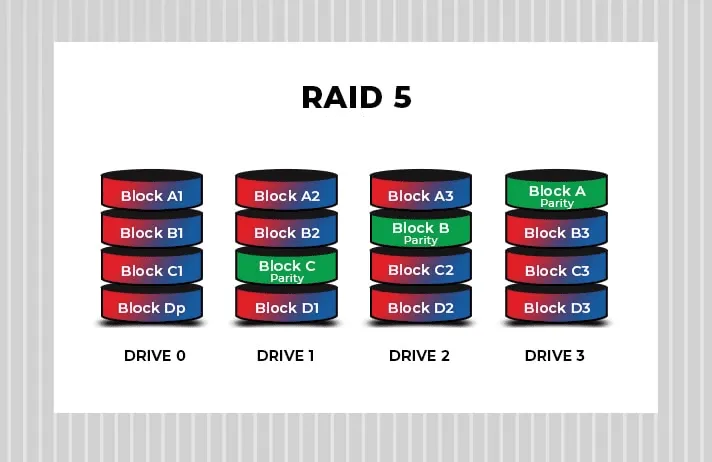RAID, which stands for Redundant Array of Independent Disks, is a widely used method for securely storing data in a large group of storage devices.
People recognize the importance of data and the problems that can arise if it is lost. Because of this, RAID storage solutions have become crucial for improving data security and ensuring its availability.
There are different levels and setups of RAID arrays, such as 0, 1, 5, 6, 10, etc., chosen based on specific usage and data storage needs. Among these, RAID 5 arrays are particularly popular in various fields, including personal use.
A RAID 5 array utilizes block-level data striping with a single parity distributed among the drives. This setup provides fault tolerance for one drive, meaning that if one drive fails, the array can still function, and data can be recovered without any loss. However, if two or more disks fail, the array will fail, resulting in data loss.
RAID 5 is favored as the most preferred RAID level because of its cost-effectiveness, high data transfer speeds, and the added benefit of fault tolerance, making it a reliable choice for many users.
What is RAID 5 Recovery?
Although RAID 5 arrays have a built-in safeguard against a single disk failure, they are not completely immune to data loss, as they can still experience failures that result in data loss. In such instances, having a reliable RAID data recovery software becomes essential. Numerous RAID 5 data recovery software options are available, offering advanced solutions for recovering data from failed RAID 5 arrays.
These software tools are capable of performing RAID recovery by virtually reconstructing a crashed RAID 5 array based on user-entered parameters. Let’s delve deeper into the causes of data loss in RAID 5 arrays and explore methods for recovering data from them.
There are a few potential causes of data loss in a RAID 5 array:
- Disk failure – If one disk in the RAID 5 array fails, the data on that disk is lost. The remaining disks can be used to reconstruct the lost data through parity, but if another disk fails before the failed disk is replaced, data loss will occur.
- Controller failure – If the RAID 5 controller fails, access to all disks is lost which can lead to data loss.
- Accidental deletion – Data can be accidentally deleted or overwritten the same way as on a single disk. RAID 5 does not prevent against accidental deletion.
- Corruption – If the data on one of the disks becomes corrupted and the corrupted data gets used to reconstruct data on a failed drive, the reconstructed data will also be corrupted leading to data loss.
- Multiple concurrent disk failures – As mentioned above, RAID 5 can only handle a single disk failure. If two or more disks fail at the same time before any failed disks can be rebuilt, data loss will occur.
- Rebuild failure – If the system fails or shuts down during a disk rebuild, the rebuild process may be corrupted leading to data loss.
How to Recover Data from Failed RAID 5 Array?
Now that we’ve got a basic grasp of how RAID 5 arrays function, let’s explore the process of recovering data from a RAID 5 that has encountered a failure or corruption. As mentioned earlier, RAID 5 provides parity, which enhances data security and accessibility in the event of a disk failure.
In the scenario where a single disk fails in a RAID 5 array, and if the enclosure or RAID controller permits, you can replace the faulty drive with a functioning one without turning off the system.
This action triggers an automatic reconstruction of the data on the newly inserted drive, restoring your RAID 5 to its operational state. Once it’s back online, you can create a backup of your data on an external storage drive.
However, if you prefer to avoid the manual process of RAID data recovery through hot-swapping disks, you can opt for specialized RAID data recovery software. This type of software is effective for both degraded drives and RAID 5 arrays that have failed logically.
These software applications excel at conducting RAID data recovery in a streamlined fashion by virtually reconstructing the RAID based on the user’s known parameters. They can also rebuild a failed RAID 5 array even when the parameters are unknown by analyzing patterns from the connected drives. After rebuilding the RAID 5 array, the software scans it to identify and retrieve recoverable data.
Conclusion
RAID 5 arrays provide several advantages for data storage, including enhanced data security and faster read/write speeds. Nevertheless, similar to other storage devices, they can experience data loss from issues like drive corruption, controller failure, or malware attacks.
Despite these challenges, there are specific methods detailed earlier in this discussion that you can employ to rectify and retrieve data from a malfunctioning RAID 5 array. We trust that this article will assist you in easily recovering data from your failed or crashed RAID 5.





